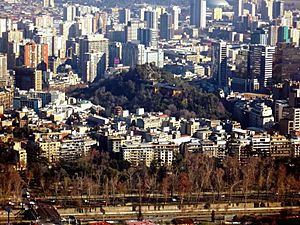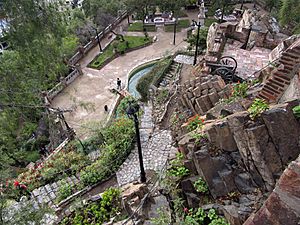Santa Lucía Hill facts for kids
Santa Lucía Hill (also called Cerro Santa Lucía in Spanish) is a small, famous hill right in the middle of Santiago, Chile. The Mapuche people, who lived there first, called it Huelén Hill. It's easy to find, located near the main street, Alameda del Libertador Bernardo O'Higgins. There's even a metro station named after it! This hill is about 629 meters (2,064 feet) high. It stands about 69 meters (226 feet) above the flat land around it. Scientists believe it's what's left of a volcano that was active about 15 million years ago.
Today, Santa Lucía Hill is a beautiful park covering about 65,300 square meters (16 acres). It has fancy walls, stairways, and fountains. At the very top, there's a great spot to look out over the city. It's a popular place for tourists and a meeting point for many.
Contents
History of Santa Lucía Hill
This hill was originally known as Huelito o heutrecan by the people who lived there before Europeans arrived. Its current name, Santa Lucía, comes from the day Pedro de Valdivia arrived and claimed the hill. This happened on December 13, 1540, which is the feast day of "Santa Lucía."
Early Uses and Forts
In 1541, during a chickenpox outbreak, missionaries used the hill as a place for worship and prayer. Later, in 1816, a military engineer named Manuel Olaguer Feliú designed and built two forts or castles on the hill. One fort was on the north side, and the other was on the south. These forts were made of stone and could hold several cannons each. Olaguer Feliú also built a place for ammunition and soldiers.
By 1820, one of these forts, Fort Hidalgo, was finished and used for defense. Another part of the hill was used as a "cemetery for the dissidents." This was for people who weren't Roman Catholic or were thought not worthy of burial in holy ground. Later, these remains were moved to a special part of the General Cemetery. Eventually, that cemetery opened to everyone, no matter their beliefs.

Observatory and City Changes
In 1849, an American naval expedition led by James Melville Gilliss set up an observatory on Santa Lucía Hill. They wanted to measure the solar parallax more accurately. When the expedition ended in 1852, the observatory and its equipment were sold to the Chilean government. This became the very first National Astronomical Observatory in Chile.
A big change came in 1872 when Benjamín Vicuña Mackenna, a mayor of Santiago, decided to completely redesign the hill. He wanted to make the city more beautiful. His team built a road that went across the hill and led to a chapel at the top. This chapel was lit by gas lamps, which were new at the time. The rest of the hill became a park with fountains and viewpoints. A special watering system was put in place to keep the plants green. The famous yellow and white walls you see today are also part of Vicuña Mackenna's redesign.
Modern Improvements
In recent years, Santa Lucía Hill has received updates to its lighting and safety features. Fort Hidalgo was also repaired and opened again for visitors. Every day, exactly at noon, a cannon shot is fired from the hill, a tradition that continues today.
Interesting Facts
On Santa Lucía Hill, there is a monument with a stone carved with words from a letter. This letter was sent by Pedro de Valdivia to Emperor Charles V. In the letter, Valdivia described the new land he had explored and conquered.
Images for kids
-
Outlook of the Pedro de Valdivia square.
-
Monument of Pedro de Valdivia
See also
 In Spanish: Cerro Santa Lucía para niños
In Spanish: Cerro Santa Lucía para niños











